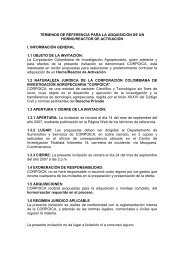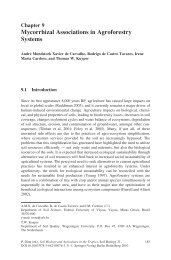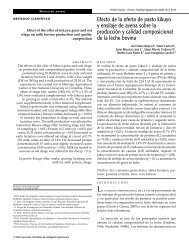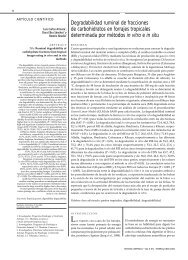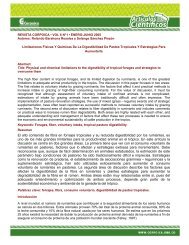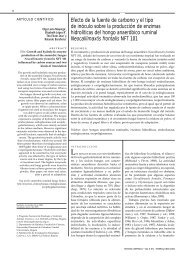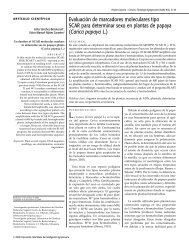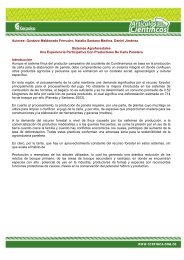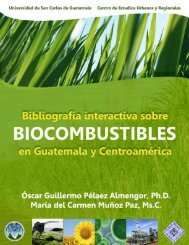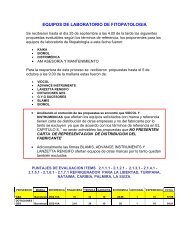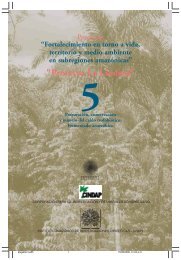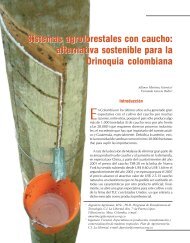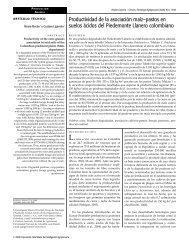Descargar Tabla de Contenido - Corpoica
Descargar Tabla de Contenido - Corpoica
Descargar Tabla de Contenido - Corpoica
Create successful ePaper yourself
Turn your PDF publications into a flip-book with our unique Google optimized e-Paper software.
Revista <strong>Corpoica</strong> – Ciencia y Tecnología Agropecuaria (2009) 10(1), 16-23<br />
ARtículo cIeNtíFIco<br />
A laboratory method for rearing An<strong>de</strong>an<br />
potato weevil Premnotrypes vorax (Coleoptera:<br />
Curculionidae)<br />
ABSTRACT<br />
The An<strong>de</strong>an potato weevil, Premnotrypes vorax, is<br />
consi<strong>de</strong>red one of the most important pests of the potato<br />
crops in Colombia. In this work, a laboratory method<br />
for rearing P. vorax is <strong>de</strong>scribed. All <strong>de</strong>velopmental<br />
stages of the insect can be obtained with this method,<br />
for experimental purposes. In addition, adult longevity<br />
and fecundity were <strong>de</strong>termined for the establishment of<br />
the potential growth of the colony un<strong>de</strong>r the evaluated<br />
conditions. Adults were kept in plastic boxes, which<br />
were provi<strong>de</strong>d with a soil layer, potato leaves for feeding<br />
and dry straw for oviposition. The dry straw with<br />
egg clutches were disinfected and incubated in Petri<br />
dishes un<strong>de</strong>r controlled conditions of temperature and<br />
humidity. The most suitable maintaining conditions<br />
for individuals in the period from larva to adult were<br />
<strong>de</strong>termined by evaluating two different feed types<br />
for larvae, three pupation substrates and three larval<br />
<strong>de</strong>nsities per tuber. The best conditions were obtained<br />
with potato tubers from the “parda pastusa” variety (><br />
80 g), on sterilized soil and peat moss in 3:1 ratio, and<br />
less those ten larvae per tuber. This rearing method<br />
can produce two or three generations per year, with an<br />
increase rate close to 17% per generation. This rearing<br />
method becomes a useful tool for bioecological studies,<br />
and to evaluate control methods for this insect.<br />
Keywords: Fecundity, An<strong>de</strong>an weevil, longevity, pest,<br />
survival.<br />
Radicado: 25 <strong>de</strong> febrero <strong>de</strong> 2009<br />
Aprobado: 7 <strong>de</strong> mayo <strong>de</strong> 2009<br />
1 Biólogo. Grupo <strong>de</strong> Manejo Fitosanitario, C.I. Tibaitatá, <strong>Corpoica</strong>, Mosquera.<br />
mperez@corpoica.org.co<br />
2 Bióloga. Universidad Militar Nueva Granada. jgarza@javeriana.edu.co<br />
3 I.A. M.Sc. Investigador máster principal, Grupo <strong>de</strong> Manejo Fitosanitario, C.I.<br />
Tibaitatá, <strong>Corpoica</strong>, Mosquera. jarguelles@corpoica.org.co<br />
Método <strong>de</strong> cría en laboratorio<br />
<strong>de</strong>l gusano blanco <strong>de</strong> la papa<br />
Premnotrypes vorax<br />
(Coleoptera: Curculionidae)<br />
Ricardo Pérez 1 , Jennifer Garza 2 , Jorge Argüelles-Cár<strong>de</strong>nas 3<br />
RESUMEN<br />
El gusano blanco <strong>de</strong> la papa Premnotrypes vorax es consi<strong>de</strong>rado<br />
uno <strong>de</strong> los insectos plaga más limitantes <strong>de</strong>l cultivo <strong>de</strong><br />
la papa en Colombia. En este trabajo se <strong>de</strong>scribe un método<br />
para la cría <strong>de</strong> P. vorax en condiciones <strong>de</strong> laboratorio, con<br />
el que se pue<strong>de</strong> obtener individuos <strong>de</strong> todos los estados<br />
<strong>de</strong> <strong>de</strong>sarrollo para su uso con propósitos experimentales.<br />
Adicionalmente, se <strong>de</strong>terminó la longevidad y fecundidad<br />
<strong>de</strong> los adultos para establecer el potencial <strong>de</strong> crecimiento<br />
<strong>de</strong> la cría en las condiciones evaluadas. Los adultos se mantuvieron<br />
en recipientes plásticos provistos <strong>de</strong> una capa <strong>de</strong><br />
suelo, follaje <strong>de</strong> papa para la alimentación y pajillas para<br />
la oviposición. Las pajillas con posturas se <strong>de</strong>sinfectaron<br />
y luego se incubaron en cajas <strong>de</strong> Petri en condiciones <strong>de</strong><br />
temperatura y humedad controladas. Las condiciones más<br />
a<strong>de</strong>cuadas para el mantenimiento <strong>de</strong> los individuos durante<br />
el período larva-adulto se <strong>de</strong>terminaron evaluando dos<br />
tipos <strong>de</strong> alimento para las larvas, tres sustratos para pupar<br />
y tres <strong>de</strong>nsida<strong>de</strong>s <strong>de</strong> larvas por tubérculo. Las mejores condiciones<br />
se obtuvieron con tubérculos <strong>de</strong> la variedad parda<br />
pastusa (> 80 g), sobre un sustrato <strong>de</strong> suelo esterilizado y<br />
turba en proporción 3:1 y a una <strong>de</strong>nsidad no mayor a diez<br />
larvas por tubérculo. Con este método <strong>de</strong> cría se podrían<br />
esperar <strong>de</strong> dos a tres generaciones <strong>de</strong>l insecto por año con<br />
una tasa <strong>de</strong> incremento cercana al 17% por generación.<br />
Este método <strong>de</strong> cría se constituye en una herramienta para<br />
facilitar la realización <strong>de</strong> estudios bioecológicos <strong>de</strong>l insecto<br />
y evaluar métodos para su control.<br />
Palabras clave: fecundidad, gorgojo <strong>de</strong> los An<strong>de</strong>s, longevidad,<br />
plaga, supervivencia.<br />
INTRODUCCIÓN<br />
M a n e j o i n t e g r a d o d e p l a g a s<br />
El gusano blanco <strong>de</strong> la papa Premnotrypes vorax (Hustache)<br />
(Coleoptera: Curculionidae) es una <strong>de</strong> las 14 especies<br />
<strong>de</strong>l complejo <strong>de</strong>nominado “gorgojos <strong>de</strong> los An<strong>de</strong>s”<br />
que atacan el cultivo <strong>de</strong> la papa. Esta especie se encuentra<br />
distribuida en Colombia, Ecuador, Venezuela y Perú<br />
don<strong>de</strong> se registra como una <strong>de</strong> las plagas clave <strong>de</strong>l cultivo<br />
(Alcázar y Cisneros, 1999). El gusano blanco en su estado<br />
adulto se alimenta principalmente <strong>de</strong> las hojas <strong>de</strong> la papa,<br />
pero el daño <strong>de</strong> importancia económica es ocasionado<br />
por las larvas, que al alimentarse <strong>de</strong> los tubérculos hacen<br />
galerías que afectan la calidad <strong>de</strong>l producto. Las pérdidas<br />
© 2009 Corporación Colombiana <strong>de</strong> Investigación Agropecuaria



